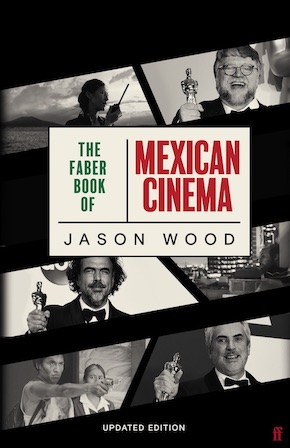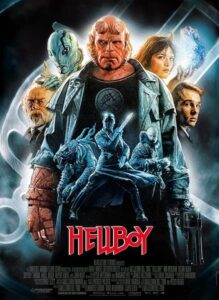Guillermo del Toro: Monster maker
by Jason WoodAlongside compatriots Alfonso Cuarón, Alejandro González Iñárritu and Carlos Reygadas, Guillermo del Toro emerged as one of the most visible and distinctive artists in modern Mexican cinema. A major contributor to the critical and commercial renaissance cinema from Mexico enjoyed on an international scale, the universal acclaim generated by Pan’s Labyrinth (2006) (which won a BAFTA and was nominated for an Academy Award) placed del Toro firmly at the forefront of contemporary filmmakers. A superlative visual stylist closely associated with horror and fantasy genres, del Toro’s work frequently examines the nightmares of the past, using history to eloquently speak of the often-traumatic passage from childhood to maturity.
A director equally at home in Spanish-language features or working on big-budget Hollywood productions such as Hellboy (2004), Pacific Rim (2008) and Crimson Peak (2015) and imbuing them with his own distinctive vision, del Toro’s artistry and profile reached new heights with The Shape of Water (2018). The winner of the Golden Lion at Venice, the film went on to triumph at all the major international awards ceremonies, winning two Golden Globes (Best Director and Best Original Score, Alexandre Desplat); three BAFTAs (including the David Lean Award for Direction) and four Academy Awards, most prominently for Best Picture and Best Achievement in Directing.
The horrors of the world
Born in Guadalajara on 9 October 1964, del Toro cites his interest in horror as springing from staying up without permission to watch episodes of The Outer Limits. One particular episode, ‘The Mutant’, especially enraptured him, the make-up applied to Warren Oates triggering an early interest in effects. Too afraid to even leave his bed in the dead of night, del Toro claims to have made a pact of friendship with the monstrous visions tormenting him. “Since this time, I have had a very intimate relationship to creatures.” Already possessed with an extremely active imagination, del Toro also cites Mexico’s gory religious imagery as a source of his fascination with the demonic and also with suffering and brutality.
It was whilst attending a Jesuit-run boys’ school that del Toro first began to nurture dreams of becoming a filmmaker, completing a number of Super 8 films at a very early age. His first serious forays into filmmaking were also shorts, with Doña Lupe (1985) and Geometria (1987) enjoying selection for a dozen international film festivals. Responsible for his own make-up and effects, it was after his involvement in a motorcycle accident that confirmed him to bed for several weeks that del Toro decided to learn the craft professionally, enrolling for a correspondence course with legendary SFX artist Dick Smith. For ten years del Toro was dedicated to this work through his company Necropia, supervising special effects make-up for several films, including Bandidos (1991), Cabeza de vaca (1991) and more than twenty episodes of the TV series La hora marcada (1986), three of which he also wrote and directed. It was through Necropia that del Toro met leading producer Bertha Navarro, with whom, alongside Laura Esquivel and Rosa Bosch he later formed the Mexico City-based production company Tequila Gang.
Winner of the Cannes Critics’ Week Award and nine Mexican Academy Awards, Cronos combines a distinctive and surreal take on the vampire yarn with an intelligent allegory about US-Mexican relations”
Cronos (1993), del Toro’s first feature, came about partly by accident. Whilst studying scriptwriting under the acclaimed Mexican director Jaime Humberto Hermosillo, del Toro had written an early draft of what would become The Devil’s Backbone. Stung by Hermosillo’s criticisms of his presentation, del Toro determined to “write something else rather than go back and rewrite the same script just because the margins weren’t right.” Inspired by a paragraph in a treatise about vampires that stated that they first vampirise the family, the fledgling director embarked on what would become Cronos. Described as a story of acceptance, the film was dedicated to his devoutly Catholic grandmother.
A bravura debut feature in which an elderly antiques dealer (Federico Luppi) discovers an artefact that once belonged to a 16th-century alchemist, unbeknownst, the device – which resembles an ornate mechanical beetle, and which was painstakingly designed by del Toro himself – houses a parasite that will grant eternal life to its host. An aversion to daylight and a thirst for human blood is the price to be paid. The winner of the Cannes Critics’ Week Award and the subsequent recipient of nine Mexican Academy Awards (and the Audience Jury Award at 1994’s Fantasporto) Cronos combines a distinctive and surreal take on the vampire yarn with an intelligent allegory about US-Mexican relations – the film is set in 1997, in a post-NAFTA (North American Free Trade Area) Mexico. A turning point in Mexican cinema, the stylishly executed work also established the template for del Toro’s subsequent career, not least in its use of symbolism and metaphor and refusal to shy away from exposing children to the horrors of the world. Leading Mexican critic Leonardo García Tsao comments, “I think that Cronos really adds something to the vampire genre. I also think that with this film del Toro demonstrated that he has a unique vision and is also able to change the rules.”
Adventures in Hollywood
Having borrowed money from his father to extricate himself from the debts accrued whilst making Cronos, and ostracised from the Mexican film industry infrastructure for his decision to work in a populist genre, del Toro found himself unable to raise the necessary finance and commitment to embark on another Mexican project. Having endured numerous ultimately unsuccessful meetings with Universal Studios concerning both an adaptation of Christopher Fowler’s Spanky and a period horror film, and unable to secure the funding or support to further develop a ghost story that would eventually become The Devil’s Backbone, del Toro pitched a short film idea to Bob and Harvey Weinstein’s Dimension outfit. The Weinstein brothers loved the concept of Mimic and persuaded del Toro to flesh it out to a feature.
After a disease carried by the common cockroach has reached epidemic proportions in Manhattan, entomologist Dr Susan Tyler (Mira Sorvino) genetically engineers a mutant species of insect that can exterminate the roaches before dying out itself. The venture is a seeming success, but a handful of years later Susan learns that people are disappearing and corpses turning up in and around the Manhattan subway. The mutant species has proved more durable and adaptable than she intended, and so alongside her colleague and partner (Jeremy Northam) and a reluctant New York subway cop (Charles S. Dutton) Susan sets out to destroy the mutant race she has unwittingly unleashed. Ostensibly a subterranean sci-fi thriller, Mimic is also a convincing parable about genetic manipulation and another expression of its creator’s preoccupation with how the ghosts of the past come back to haunt us. Although proud of certain sequences, del Toro is not an admirer of the film and describes it as a painful experience. “Back then it was the most expensive movie Dimension had ever made and it was also by far the most expensive movie I had ever done. I experienced many hardships with that movie. I sustain the belief that you learn through pain and I certainly learned a hell of a lot.”
Scarred by the process of trying to make a personal film with increased resources but in ultimately impossible circumstances, del Toro took comfort from the success of Amores Perros (with del Toro advising González Iñárritu during the film’s editing) and Cuarón’s homecoming movie Y tu mama también and returned to Tequila Gang and Spanish-language productions with the long in gestation, Agustín and Pedro Almodóvar produced The Devil’s Backbone (El Espinazo del Diablo, 2001). Set in 1938, with Franco’s forces poised to rout the Republicans, the film concerns 10-year-old Carlos (Fernando Tielve), the son of a fallen Republican who is sent to a remote orphanage run by sympathetic leftists Carmen (Marisa Paredes) and Casares (Federico Luppi). But there is much there to unnerve him, from the attentions of bullies to an unexploded bomb in the courtyard; the ominous approach of Franco’s troops to the orphanage’s walls; teacher Conchita’s (Irene Vicido) brooding boyfriend Jacinto (Eduardo Noriega); and the presence of the ghost of a boy called Santi, who ominously predicts, “Many of you will die…”
Featuring superlative special effects and consummate performances, the film’s use of Fascism as a parable would become another abiding theme.”
Originating from an early del Toro drawing of a man drowning in a pool of blood, the film, which also references Hitchcock and Buñuel, was at one time to have been set during the Mexican Revolution. Featuring superlative special effects and consummate performances, the film’s use of Fascism as a parable would become another abiding theme. “You have Fascism represented by Jacinto, and you have the people, represented by the children, and you have the old Republicans represented by Carmen and Casares. It’s a movie that doesn’t say that everything ends up happily, it says that the bomb never exploded, the ghost never left the place and the only thing you have as a positive is that the children are going to march.” The film also retains the favouring of a stylised and heightened representation of reality, with del Toro and regular cinematographer Guillermo Navarro chiming perfectly. “I always try to take it a couple of notches above. The Spanish Civil War in The Devil’s Backbone looks like a Sergio Leone western, except at night where it looks like a Mario Bava movie.” Once again critics and audiences purred.
Del Toro’s next two assignments would take him back to American studio projects with Blade II (2002) and Hellboy (2004). The first picture signalled the return to the screen of Marv Wolfman and Gene Golan’s hugely popular comic-book vampire/warrior hybrid. Meshing stylishly executed set pieces with del Toro’s eye for the macabre, this exhilarating and visceral blockbuster concerns the eponymous anti-hero’s (Wesley Snipes) attempts to reverse a new super-race of indiscriminate blood guzzlers from taking over the world. Del Toro speaks of the film fondly. “It was a very joyful experience. It was the opposite to Mimic in that I didn’t have any aspirations to making a personal film and just wanted to give a personal touch to a movie that was unequivocally commercial. I was in total agreement with the producers and the studio on the movie we were making.”
Del Toro’s third collaboration with actor Ron Perlman, Hellboy was an even more thrilling experience and a project on which the director achieved the difficult synthesis of articulating a personal vision within a Hollywood structure. “Hellboy is ultimately what I think an atomic adventure book movie could be and is very different from the other comic book franchises. It has a huge heart and a lot of beauty in the horror. It’s also a celebration of otherness and being different. It is a beauty-and-the-beast story where at the end they kiss and they both turn to beasts.”
During World War II, the Third Reich has joined forces with the evil Grigori Rasputin (Karel Roden), who has used his occult powers to summon up a young demon from the depths of Hell to be used as the ultimate weapon. However, the demonic creature is captured by American forces, and put in the care of Professor Broom (John Hurt), the founder of a top-secret organisation called the Bureau for Paranormal Research and Defence. Under Broom’s tutelage, the creature develops empathy and a desire to do good, while his physical powers and paranormal talents are finely honed. Many years later, the demon, now known as Hellboy (Perlman), is part of an elite secret-defence team alongside Liz Sherman (Selma Blair), a woman who can create fire with her mind, and Abe Sapian (Doug Jones), an aquatic humanoid with the power of telepathy. Hellboy finds himself facing his greatest challenge when the powerful Rasputin returns, determined to bring the demon back to the forces of darkness so that evil may finally rule the world. Adapted from Mike Mignola’s cult comic-book series, Hellboy achieves an intelligence not commonly associated with such fare. Del Toro initially committed to a number of sequels but Hellboy 2: The Golden Army will be his last contribution.
Inside the labyrinth
Screened in the main competition at the 2006 Cannes Film Festival, Pan’s Labyrinth (El Laberinto del fauno, 2006) marked another fruitful return to Latin-American productions and is arguably the Mexican maestro’s first masterpiece.
Spain, 1944. Recently remarried Carmen (Adriadna Gil) moves with her daughter Ofelia (Ivana Baquero) into the house of her new husband, coldly authoritarian Vidal (a superbly fearsome Sergi López), a captain in General Franco’s army. Finding her new life hard to bear, young Ofelia seeks refuge in a mysterious labyrinth she discovers next to the sprawling family house. Pan, the guardian, a fantastical creature, reveals that she is none other than the long-lost princess of a magical kingdom. To discover the truth, Ofelia will have to accomplish three dangerous tasks, which nothing has prepared her to face…
A year’s preparation, four months shooting, and six months of post-production were necessary for del Toro to realise Pan’s Labyrinth, the film of which the director claims to be most proud. Del Toro has always been inspired by the paintings of Francisco Goya, especially his ‘black’ paintings – for the director Goya’s most impressive – but for Pan’s he drew most heavily on the influence of illustrator Arthur Rackham. The painting of Satan devouring his son, for example, was a principal inspiration for the Pale Man, one of the main characters in the Labyrinth. Del Toro tried to connect with the perversity and very carnal content of Rackham’s work.
The conception of the imaginary world in which Ofelia seeks refuge and Pan roams was entrusted to Carlos Gimenez for the sketches and then to David Marti and his company Efectos Especiales to give them form and bring them to life. Gimenez took care of designing the Labyrinth while Sergio Sandoval, who created Kroenen’s masks for Hellboy, concentrated on the creatures, in particular Pan. For this character, which del Toro wanted to be as organic as possible, it was decided that his lower body would be covered with foliage and branches, as if truly and corporeally he was part of nature. To achieve this the filmmakers used virtually no digital effects whatsoever. Everything was done on the set with the help of animatronics, a first in the history of Spanish cinema.
For me, Fascism represents the ultimate horror and for this reason is an ideal subject through which to tell a fairy tale for adults.”
Garlanded with acclaim and already one of the most commercially successful foreign-language films in recent memory (not to mention the recipient of three American and British Academy Awards and nine Mexican Academy Awards, including the Golden Ariél and Best Direction), the film clearly echoes The Devil’s Backbone in its Spanish Civil War setting and its dealing with repression and the very essence of Fascism. “For me, Fascism represents the ultimate horror and for this reason is an ideal subject through which to tell a fairy tale for adults. Because Fascism is above all a form of perversion of innocence, and thus childhood. Thus the real ‘monster’ of the film is Captain Vidal.” A fairy tale, a political fable and a brilliant depiction of the intersecting worlds of fantasy and fiction and of adulthood and innocence, Alfonso Cuarón, one of the film’s producers, proudly describes Pan’s Labyrinth as representing “An explosion of the full potential of Guillermo’s mind.”
As well as his own ongoing efforts behind the camera, del Toro has shown his commitment to cinema from Mexico by acting as a producer on a number of diverse projects by both established filmmakers and newer talents. Rudo y Cursi, the full-length debut feature of writer Carlos Cuarón, and Cosas insignificantes by Andrea Martínez are just two of the pictures to which the hardworking del Toro committed himself. “If you do not water your roots then you will go dry. It is incredibly important that Bertha, Alejandro and I continue producing. The key to life is flow and if you don’t make things flow they die. You have to make your experiences go beyond yourself and count for other people.”
Pacific Rim (2013) again demonstrated del Toro’s ability to deliver big-budget thrills with distinction whilst Crimson Peak (2015), set in the aftermath of a family tragedy in which an aspiring author is torn between love for her childhood friend and the temptation of a mysterious outsider, offered a distinctive and distinguished update on the age-old haunted house set-up. A film of imagination and daring execution, it’s very much characteristic of its creator’s attention to detail, no matter what the scale of the production.
The Shape of Water
Cementing the Mexican stronghold on the Best Director category at the Academy Awards by joining compatriots Alejandro Gonzàlez Iñàrritu and Alfonso Cuarón in the winners’ circle, with The Shape of Water del Toro also struck a blow for the recognition of genre movies in terms of prestige.
Using his acceptance speech as a humanist call for inclusion, del Toro, by highlighting his immigrant status, also reinforced many of the themes of not only his latest, immaculately executed work but also of earlier, career-defining films such as Cronos, The Devil’s Backbone, Pan’s Labyrinth and Hellboy. The director may work within the realms of horror and fantasy, elevating them to high art, but his films very much reflect the injustices suffered by those whose gender, sexual preferences or race renders them as outsiders. The director has asserted “that I identify with monsters” and arguably no filmmaker has plumbed the soul of screen monsters with such empathy.
Opening with a voiceover to establish the film’s fable-like tone and 1960s Cold War backdrop, The Shape of Water reaffirms the notion that the monstrous comes in many forms. Elisa (Sally Hawkins, sublime) is a mute who toils as a janitor at a US Government laboratory. One night, a strange amphibious creature (del Toro regular Doug Jones) is wrangled into the facility by a sadistic federal agent (Michael Shannon, playing characteristically self-serving and cruel). A sympathetic scientist at the facility detects in the creature the ability to communicate and wishes to learn from it, but his adversary is adamant that it must be killed to stop it falling into Soviet hands. As a physical and emotional bond between them tightens, Elisa, in cahoots with a black co-worker (Octavia Spencer) and a lonely artist neighbour (Richard Jenkins), forced to hide his sexuality, hatches a plan to save the creature’s life, even at the risk of her own.
Featuring a plethora of cinema allusions with The Creature From the Black Lagoon as an obvious starting point (a setting above an old cinema allows del Toro, who cites Sirk and Minnelli as influences, to indulge other references), a love of movie history is however no prerequisite for enjoyment. Featuring multiple layers of subtle social critique, The Shape of Water eloquently stitches together first-rate performances, jaw-dropping production design, fluid camerawork highlighting the film’s aquatics, and a gorgeous score from Alexandre Desplat. Funny, romantic, terrifying and politically engaged, this is the work of a consummate artist operating at the very height of his considerable powers.
At the time of writing del Toro is in the final post-production stages on Nightmare Alley. Set for international release in December 2021, the film is an update of the 1947 Tyrone Power-starring noir directed by Edmund Goulding. Working with co-writer Kim Morgan from the William Lindsay Gresham novel, del Toro has again assembled an all-star cast including Toni Collette, David Strathairn, Cate Blanchett, Bradley Cooper and Rooney Mara. Ron Perlman, who introduced the director to the novel in 1992, also returns.
Reinstating the sexuality and darker underbelly of the source novel, which would have been impossible in 1947, del Toro has spoken of mining the book “for little nuggets that somebody didn’t mine.” It’s fair to say anticipation is running high…
 Jason Wood is the Creative Director for Film and Culture at HOME, Manchester. A visiting Professor at Manchester School of Art, he is the author of various books on cinema and recently collaborated with Bob Stanley on Café Exil, which was voted Rough Trade’s compilation of the year for 2020. His revised edition of The Faber Book of Mexican Cinema, featuring a raft of new interviews with filmmakers and features on recent releases, is out now in paperback.
Jason Wood is the Creative Director for Film and Culture at HOME, Manchester. A visiting Professor at Manchester School of Art, he is the author of various books on cinema and recently collaborated with Bob Stanley on Café Exil, which was voted Rough Trade’s compilation of the year for 2020. His revised edition of The Faber Book of Mexican Cinema, featuring a raft of new interviews with filmmakers and features on recent releases, is out now in paperback.
Read more
homemcr.org
@jwoodfilm
@FaberBooks
Author portrait © Rebecca Lupton






